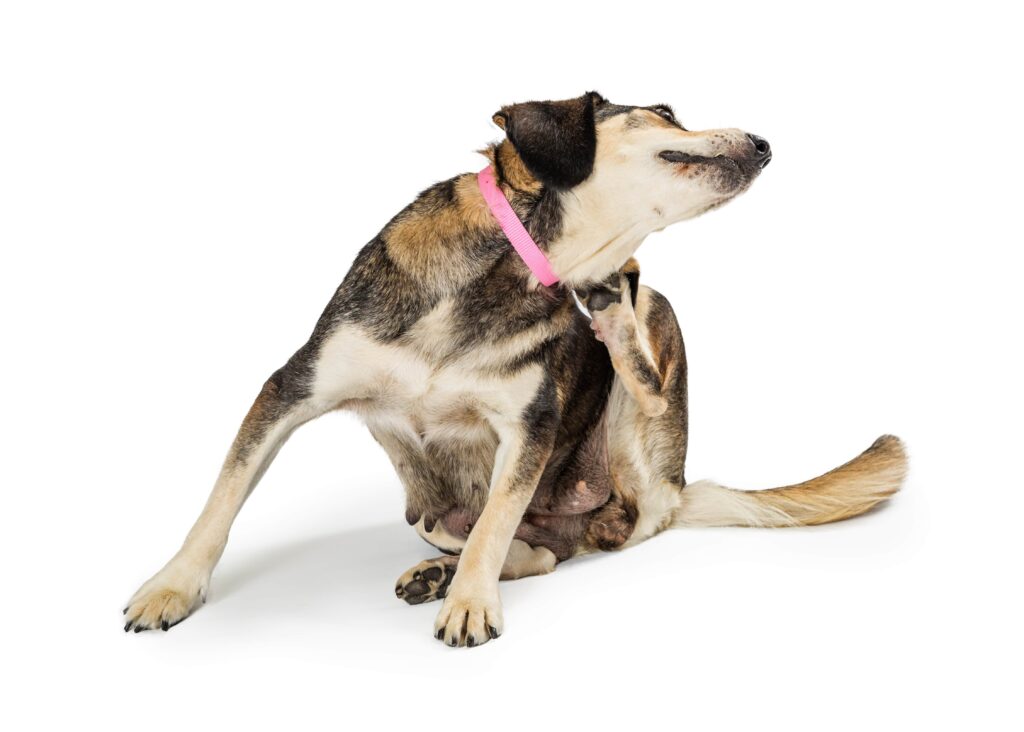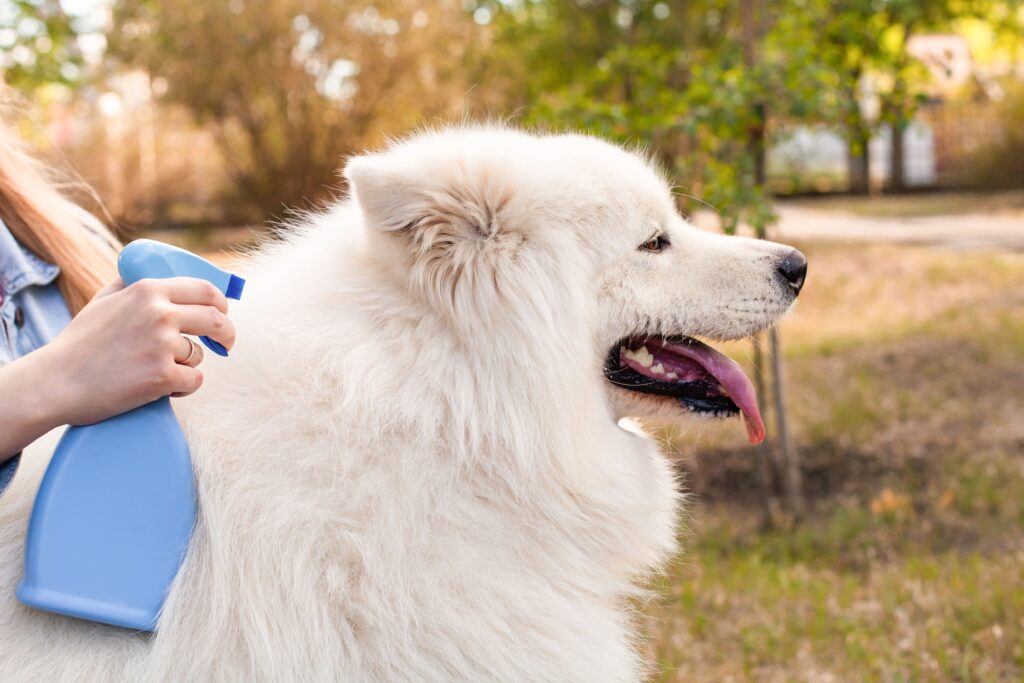Fleas, those tiny, annoying insects, may seem like harmless nuisances at first glance. But let’s not underestimate the havoc they can wreak on our beloved pets. These pesky critters can cause severe discomfort and health issues for our furry companions, making it imperative to take flea control seriously.
One of the primary reasons we need to prioritize flea control is the fact that fleas are not just a nuisance; they are skilled bloodsuckers. These tiny parasites survive by biting into your pet’s skin and feeding on their blood.
This constant biting can lead to intense itching, redness, inflammation, and even allergic reactions in some pets. Moreover, fleas are notorious for spreading diseases such as tapeworms and Bartonella (also known as “cat scratch disease”) to both cats and dogs.
Overview of the Factors to Consider when Choosing a Flea Control Product

Now that we understand why flea control is crucial let’s dive into choosing the right flea control product for your pet. With so many options available in the market today, it can be overwhelming trying to figure out which product will be most effective and safe for your furry friend.
When narrowing down your choices, there are several factors that you should take into consideration. First and foremost is your pet’s individual needs.
Every pet is unique in terms of species (dog or cat), age (puppy or senior), health condition (healthy or with existing medical issues), and any allergies or sensitivities they may have. In addition to considering your pet’s needs, you’ll also want to think about convenience factors such as ease of application and duration of effectiveness.
Some products come in oral form while others are applied topically using sprays or spot-on treatments – each with its own advantages and considerations. It’s also essential to weigh the safety of the active ingredients used in these treatments and their potential side effects.
Brief Explanation of the Flea Life Cycle
Fleas, those pesky little critters that can wreak havoc on our beloved pets, have a life cycle consisting of four stages: egg, larva, pupa, and adult. Understanding this life cycle is crucial in effectively combating flea infestations.
It all begins when an adult female flea lays her eggs on your pet’s fur. These tiny eggs can easily fall off onto your pet’s bedding or around your home.
In just a few days, these eggs hatch into larvae that feed on organic debris, such as flea feces or skin cells. The larvae then spin cocoons and enter the pupal stage, where they develop into adult fleas.
Why Targeting Multiple Stages Is Crucial for Effective Control
Now here’s the important part – killing only adult fleas won’t solve the problem kills adult fleas entirely! Adult fleas constitute just a fraction of the population. The majority of fleas exist in their pre-adult stages – eggs, larvae, and pupae – which are less susceptible to many flea treatments.
If you only focus on killing adult fleas with topical treatments or oral medications, you’ll miss out on eradicating the entire dog flea population. By targeting multiple stages of the flea life cycle simultaneously, you can prevent reinfestation and effectively control flea populations in your home.
This is where products that contain insect growth regulators (IGRs) come into play. IGRs work by disrupting the development of immature fleas at various stages of their life cycle – preventing them from reaching adulthood and reproducing.
By including IGRs in your choice of flea control product, you ensure a comprehensive approach to combat these bothersome parasites. Additionally, it’s worth mentioning that frequent use of effective flea treatments is necessary because some products may not always kill fleas at all life stages.
Some topical medications, for example, may only kill adult fleas and not the eggs or larvae. Therefore, combining treatments that target different stages, such as using a topical treatment alongside a flea collar or oral medication with IGRs, can provide superior protection against flea infestations.
So remember, when selecting a flea control product for your pet, ensure it addresses multiple stages of the flea life cycle. This way, you’ll break the reproductive cycle of these persistent pests and provide your furry friend with the long-lasting relief they deserve.
Assessing Your Pet’s Needs
When it comes to choosing the right flea control product for your beloved pet, it’s crucial to assess their specific needs. One of the first factors to consider is your pet’s species.
Different animals have different sensitivities and requirements when it comes to flea control. For example, a flea and a tick prevention product that works wonders for a dog might not be suitable for a cat or vice versa.
It’s important to select a product specifically formulated for your pet’s species. Age also plays a vital role in determining the appropriate flea control treatment.
Young puppies or kittens have fragile systems that may not tolerate certain chemicals found in adult flea and tick treatments. In such cases, it is recommended to consult with a veterinarian before administering any products.
Likewise, older pets might have underlying health conditions that require extra caution when choosing products. Take into account any existing medical issues and discuss them with your vet.
Identifying any existing allergies or sensitivities
Just like humans, pets can also have allergies or sensitivities to certain substances commonly found in flea control products. Before applying anything on your furry friend, it’s essential to identify if they have any known allergies or sensitivities. This information will guide you in selecting an appropriate product that won’t trigger adverse reactions.
If you suspect an allergy but are unsure about specific ingredients causing it, consulting with a veterinarian is highly recommended. They can conduct tests to determine potential allergens and help you make an informed decision about which products are safe for use on your pet.
Remember that there is no one-size-fits-all approach when it comes to choosing the right flea treatment for your pet; each animal is unique and requires personalized attention and care. By considering their species, age, health condition, as well as any known allergies or sensitivities, you are taking essential steps towards ensuring their well-being and finding the most effective flea control product for them.
So, take the time to assess your pet’s needs thoroughly before making a decision. Your furry friend will thank you for it!
Types of Flea Control Products
Topical Treatments: How they work and their pros and cons

When it comes to combating fleas, topical treatments have proven to be a popular choice among pet owners.
These oral flea treatments usually come in the form of spot-on applications that are applied directly onto the skin, targeting both adult fleas and their eggs. The active ingredients in these products work by either repelling or killing adult fleas upon contact, preventing them from biting your furry friend.
One key advantage of spot-on treatments is their ease of use. Applying the product typically involves parting your pet’s fur and squeezing out the desired amount onto their skin, usually between the shoulder blades or at the base of the neck.
Additionally, these treatments often remain effective for several weeks or even months, providing continuous protection against flea infestations. However, it’s important to note that spot-on treatments may have some potential downsides as well.
Some pets may experience mild irritation at the application site, but this usually resolves quickly. Additionally, if you own multiple pets that groom each other frequently, you should ensure that they don’t lick or ingest each other’s medication after application.
Collars: Features, duration, and potential side effects

Flea collars have long been a staple in flea control for pets due to their convenience and prolonged effectiveness.
These collars contain insecticidal agents that slowly release onto your pet’s skin and coat to kill adult fleas as well as repel ticks and chewing lice. One notable advantage of flea collars is their duration of effectiveness – many can provide protection for up to eight months to several months without needing frequent reapplication.
They are easy to use; simply fasten them around your pet’s neck, ensuring a snug fit that allows for a two-finger gap between the collar and the dog’s skin. Nevertheless, it’s essential to be aware of potential side effects associated with flea collars.
Some dogs may experience temporary skin irritation or allergic reactions at the collar site, which usually resolve once the collar is removed. Additionally, while many modern flea collars offer improved safety measures, it’s important to follow the manufacturer’s instructions regarding safe usage and ensure that they are not too tight or loose-fitting.
Oral Medications: How they work and their pros and cons

Oral medications for flea control offer an alternative approach that eliminates the need for topical application.
These medications come in various forms such as pills or chewable tablets and generally work by entering your pet’s bloodstream after ingestion. They target fleas from within, killing them when they bite your pet.
One significant advantage of oral medications is their convenience. Administering these treatments is often as simple as hiding a pill in your pet’s food or giving them a tasty chewable tablet, making it easier for pets who dislike topical applications.
Furthermore, oral medications tend to provide systemic protection against fleas more effectively than spot-on treatments alone. However, it’s crucial to note that some oral medications require monthly administration to maintain continuous protection.
Additionally, like any medication, there can be potential side effects such as gastrointestinal upset or allergic reactions in rare cases. As always, consult with your veterinarian to determine the right dosage and frequency of administration based on your pet’s specific needs.
Remember that each type of flea control product has its own set of pros and cons. Whether you opt for topical treatments like spot-on applications or choose oral medications for convenience purposes, it’s important to consider factors such as your pet’s lifestyle, preferences, and any existing allergies or sensitivities when making your decision about which flea control product is the right fit for your furry friend.
Prescription vs Over-the-Counter Products

When it comes to choosing a flea control product for your furry friend, you may find yourself faced with the decision between prescription and over-the-counter options. While both have their merits, prescription products offer several advantages that make them worth considering.
One of the key benefits is their effectiveness in tackling severe infestations or specific conditions. Prescription products tend to contain stronger active ingredients that are designed to target and eradicate even the most stubborn fleas.
These products are formulated to kill adult fleas, as well as interrupt the flea life cycle by targeting the flea eggs, larvae, and pupae. If your pet is dealing with a severe flea problem, prescription treatments can provide faster and more comprehensive relief.
Recommended for severe infestations or specific conditions
Prescription flea control products are often recommended by veterinarians when pets are facing severe infestations or have specific conditions that require extra care. For instance, if your dog has an underlying health condition such as skin irritation or allergies caused by fleas, a prescription product may be the best option.
These specialized treatments can help alleviate discomfort and address any secondary complications associated with flea bites. Moreover, if you’ve tried over-the-counter options without success or need additional support in managing recurring infestations, consulting a veterinarian for a prescription treatment is highly advisable.
Potential access to a wider range of options
When it comes to flea control products, having access to a wide range of options increases your chances of finding the most effective solution for your pet’s needs. Prescription medications often provide this advantage due to their availability in various forms such as topical treatments or oral medications. Additionally, prescriptions offer different active ingredients that might not be found in over-the-counter alternatives.
This variety allows veterinarians to tailor solutions based on the specific situation, ensuring the treatment is both effective and safe for your furry friend. By opting for a prescribed flea control product, you gain access to a diverse selection that can be customized to suit your pet’s individual circumstances.
Choosing the right prescription product
When considering prescription flea control products, it is essential to consult with your veterinarian. They will examine your pet’s health history and current condition to recommend the most suitable options.
The veterinarian will take into account factors such as age, breed, weight, and any ongoing medications or allergies. It’s important to remember that some prescription products can also provide protection against ticks and other parasites if needed.
This versatility is particularly beneficial in areas where tick-borne diseases like Lyme disease are prevalent. By working closely with your veterinarian, you can ensure that you choose a prescription product that effectively tackles fleas while addressing any additional concerns specific to your pet.
Remember, when it comes to selecting the right flea control product for your beloved companion, don’t hesitate to reach out for professional guidance. Veterinary expertise combined with prescription products offers an effective solution that prioritizes both efficacy and safety.
Choosing the Right Product for Your Pet’s Lifestyle
Outdoor vs Indoor Lifestyle

When it comes to choosing a flea control product for your pet, one of the key factors to consider is their lifestyle, particularly whether they spend most of their time indoors or outdoors. Outdoor pets are naturally more prone to flea infestations as they have greater exposure to environments where fleas thrive. In such cases, opting for a comprehensive flea infestation and control method that targets both adult fleas and their larvae is essential.
Topical flea treatments or oral medications that provide long-lasting protection can be an excellent choice for outdoor cats and dogs. For indoor pets who rarely venture outside, the risk of flea infestations may be lower.
However, it’s important to remember that fleas don’t discriminate and can find their way into your home through various means like other animals or even humans. Therefore, even if your pet spends most of their time indoors, you should still consider using preventive measures like regular grooming with a flea comb or using spot-on topical treatments that repel fleas effectively.
Exposure to Other Animals

Pets who frequently come into contact with other animals (such as during walks in the park or playdates with fellow furry friends) have an increased likelihood of encountering fleas. In such cases, it’s crucial to choose a flea control product that not only protects your pet but also prevents them from bringing home unwanted passengers.
If your pet enjoys socializing with other animals on a regular basis, you might want to opt for long-lasting topical treatments or oral medications specifically designed to repel fleas and ticks. These products often provide extended protection against multiple pests and flea and tick medications and can significantly reduce the chances of infestations caused by contact with other animals.
Travel Habits
For adventurous pet owners who love traveling with their four-legged companions, considering their travel habits is vital when selecting a flea and tick control product. Whether you embark on hiking adventures, beach trips, or simply visit different environments, your pet’s exposure to fleas and ticks may vary. If you frequently take your pet to areas known for heavy flea or tick infestations, it’s wise to choose a product that offers broad-spectrum protection against both pests.
Look for topical treatments or oral medications that not only eliminate existing fleas but also repel future infestations. Furthermore, if your travels involve long-term stays in areas where specific parasites like sand fleas are prevalent, consulting with a veterinarian becomes even more important.
They can recommend suitable products that target these specific parasites and provide effective protection during your travels. Choosing the right flea control product for your pet requires considering their lifestyle factors such as indoor versus outdoor living, exposure to other animals, and travel habits.
By carefully evaluating these aspects and selecting appropriate preventive measures like topical treatments or oral medications tailored to your pet’s needs, you can ensure they stay protected from pesky fleas and other potential pests. Remember, consulting with a veterinarian is always beneficial as they can provide personalized advice based on your pet’s unique circumstances.
Considering Environmental Impact

Evaluating the impact on your pet’s surroundings
When choosing a flea control product for your beloved furry friend, it is important to consider not only its effectiveness but also its impact on the environment. Flea and other tick treatment products often contain chemicals that can end up in our surroundings, including soil, water sources, and even other animals.
Evaluating the potential environmental impact of these products is crucial to ensure we are making responsible choices. One way to assess the impact on your pet’s surroundings is by looking at the active ingredients in the flea control product.
Some chemicals may have a higher likelihood of leaching into the environment than others. It’s worth researching whether these ingredients are known to persist in soil or have adverse effects on aquatic life.
Opting for products with environmentally friendly active ingredients or those that break down more quickly can help minimize their impact. Additionally, consider how you dispose of any unused or empty flea control product containers.
Always follow proper disposal procedures recommended by manufacturers or local authorities to prevent any harmful substances from entering ecosystems. By being mindful of how these products affect our environment, we can contribute to maintaining a healthier planet for future generations.
Looking for eco-friendly options
As awareness about environmental sustainability grows, manufacturers have started developing eco-friendly flea control alternatives that are safer for both pets and the planet. These options prioritize using natural ingredients or employing innovative techniques that reduce reliance on harmful chemicals.
One eco-friendly option gaining popularity is essential oil-based flea and tick collar repellents. Natural oils like neem oil, lavender oil, and citronella are known to repel fleas and ticks without posing significant risks to the environment.
However, it’s important to note that essential oils should always be used with caution as they can be toxic if ingested in large quantities or applied directly onto pets’ skin without proper dilution. Another environmentally conscious choice is flea control products made from sustainable, organic, or biodegradable materials.
These products often come in packaging that is recyclable or made from recycled materials, reducing waste and minimizing their carbon footprint. By opting for eco-friendly flea control options, you can effectively combat fleas while also doing your part to protect the environment.
Remember to read product labels carefully and look for certifications or seals that signify a commitment to sustainability. Considering the environmental impact of flea control products is an essential step in choosing the right one for your pet.
Evaluating how these products can affect your pet’s surroundings and opting for eco-friendly alternatives can make a significant difference in preserving our ecosystems. By making informed choices, we can protect our pets from fleas while contributing to a greener and more sustainable future for all.
Seeking Professional Advice

Importance of consulting with a veterinarian
When it comes to choosing the right flea control product for your beloved pet, seeking professional advice from a veterinarian is crucial. Vets have extensive knowledge and experience in dealing with fleas and ticks, and they can provide invaluable guidance tailored to your pet’s specific needs. They will consider factors like your pet’s age, species, overall health condition, and any existing allergies or sensitivities before recommending the most suitable flea spray options.
Getting personalized recommendations based on your pet’s needs
During a consultation with your vet, they will conduct a thorough examination of your pet to assess their current flea or tick situation. Based on their findings, they can recommend the right flea treatment that effectively targets both adult fleas and their eggs or larvae. Your vet might suggest spot-on treatments applied between the shoulder blades or recommend oral flea and tick medications, that kill adult fleas when ingested by your pet.
Addressing other health concerns and parasite control
In addition to discussing the best flea treatments and control products, consulting with a veterinarian allows you to address any other health concerns related to parasites. Fleas and ticks can transmit diseases and cause discomfort for animals; therefore, it is essential to ensure all aspects of parasite control are covered. Your vet may recommend products that provide protection against not only fleas but also ticks or intestinal parasites like worms.
Conclusion
Choosing the right flea control product for your furry friend can be overwhelming given the multitude of options available in today’s market. However, by seeking professional advice from a knowledgeable veterinarian, you can gain peace of mind knowing that you are making an informed decision based on expert recommendations tailored specifically for your pet’s needs. Remember that each animal is unique, so what might work for one may not be suitable for another.
By following the guidance of your vet, you are taking a proactive step towards ensuring the well-being and comfort of your beloved pet. Together, you can conquer flea and tick troubles, providing a happier, healthier life for your furry companion.
Exterminate fleas with D-Termination: Las Vegas’ leading pest control service!

If you’re facing flea problems on your Las Vegas property, turn to D-Termination for assistance. Our expert team specializes in eliminating flea infestations and restoring comfort and peace to your space. Bid farewell to fleas—opt for D-Termination for effective pest control today!
Reach out to us at 702-919-6310 or visit dtermination.com to schedule your flea control service and reclaim your space from these bothersome pests.
Frequently Asked Questions:
The number one vet-recommended flea treatment varies, but options include topicals like Frontline or oral medications like NexGard.
The most effective flea control method often involves a combination of treatments, including topical or oral medications, regular grooming, and maintaining a clean environment.
Vets commonly recommend prescription-strength flea treatments, such as Bravecto, Revolution, or Comfortis.
The choice between liquid and pill flea medicine depends on the specific product and your pet’s preferences, but both can be effective when used as directed.








